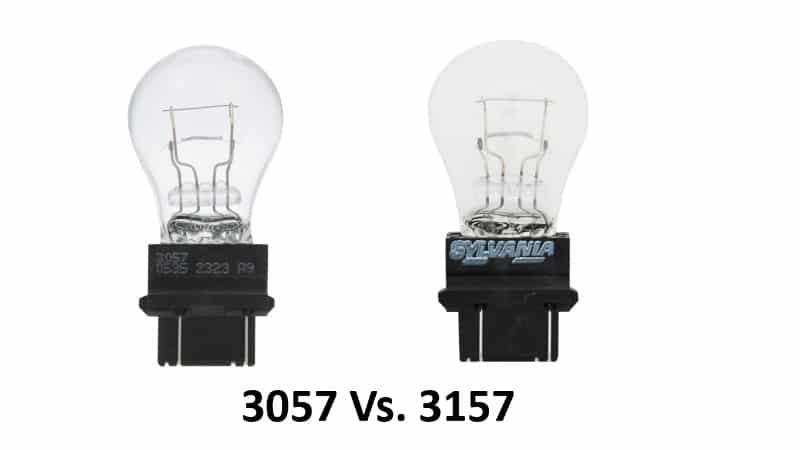In this article, we’ll be taking a look at the main differences between 3057 and 3157 bulbs.
Both of these bulbs are interchangeable and are often used in similar applications. That said, there are a number of differences that make them better suited for different uses.
3057 bulbs are rated to work at lower wattage and less bright than 3157 bulbs. Moreover, 3157 bulbs have a better lifespan and cost less than 3057 bulbs.
If you’re still unsure which bulb to pick, we have tested the vast majority of options and can help you make a better choice.
Keep reading for more information on the differences between 3157 and 3057 bulbs.
| 3057 | 3157 |
| A bit less bright | Brighter light output |
| Not bright enough to be used as daytime running lights | Can be used as daytime running bulbs |
| Shorter lifespan of around 1200-5000 hours with regular use | Longer lifespan estimated around 2000-10,000 hours with regular use |
| More power efficient than 3057 | Uses more power than 3157 bulbs |
| More expensive option | Costs less than 3057 bulbs |
| Not designed for ‘always-on’ use | Can stay turned on for longer periods at a time |
| Prone to heat damage | Can be mounted closer to hot parts of the car such as the engine bay, exhaust system, etc |
3057 and 3157 Bulbs Compared
Wattage
3057 bulbs have a lot of advantages over their 3157 counterparts. 3057 bulbs use less energy and are more power efficient than 3157 bulbs.
One downside is that 3057 generates a slightly dimmer light than 3157 bulbs. However, if you’re looking for a more energy efficient option, 3057 bulbs are the obvious choice.
Brightness
3157 bulbs generate a brighter, clearer, more visible beam of light thanks to their higher power rating
In testing, we noticed that 3157 bulbs were more visible and easy to spot even in non-ideal conditions such as rain, fog, and dust than 3057 bulbs.
Lifespan
3157 bulbs boast a lifespan between 2000 and 10,000 hours, far outshining that of 3057 bulbs which get between 1200 and 5000 hours. For the driver who is tired of constantly changing out the bulbs. 3157 bulbs offer far better longevity.
Use case
Because of the variation in power ratings and brightness levels, these two bulbs are suited for different uses.
While both bulbs can be used in reversing lights, brake lights, turn signals, etc. 3157 bulbs take the win as they are bright enough also to be used as daytime running lights that are visible in direct sunlight and other high ambient light scenarios.
3057 bulbs, on the other hand, are not nearly bright enough to work well outdoors during the day. Moreover, 3157 bulbs have significantly better cooling, allowing them to offer high performance even after hours of continuous use.
They are more resistant to heat damage and can be used near hotter parts of the car, such as the engine bay and exhaust system.
Price
The nail in 3057 bulbs’ coffin is price. 3057’s lose out to the 3157s in terms of performance, but they are also priced higher.
Some manufacturers have these bulbs listed at two times the price of similar or better-performing 3157 bulbs.
Format
When comparing the two models, it is challenging to spot any noticeable differences at first glance. Both models share an identical shape, featuring a miniature S-8 bulb, two filaments, and a plastic wedge-shaped DF base. Additionally, both types are available in incandescent, halogen, and LED variations.
To differentiate between them, we need to shift our focus to their ID codes. These numerical designations are referred to as ANSI codes, which stands for the American National Standards Institute. Despite sounding mundane, these codes hold the key to understanding the substantial distinction between these two remarkably similar bulbs.
The final two digits of the bulb’s code indicate its shape and base, which happen to be identical in this case. The first digit, representing the output of the “high” filament, remains consistent without any variation. Consequently, the sole disparity between the two lies in the “low” filament and its associated second digit, indicating that 3157 bulbs are brighter compared to 3057 bulbs.
Illumination and Wattage
As previously mentioned, both bulb models incorporate a dual filament design, allowing for the generation of two distinct levels of illumination. This unique configuration effectively combines the capabilities of two separate bulbs into a single unit, offering versatility for various lighting applications. One common example is the integration of a parking light with a brake light, a sought-after feature found in many modern vehicles.
To provide a quantitative comparison, we can utilize a measurement known as Candle Power (CP). In terms of the “high” filament, both bulbs emit an approximate output of 32 CP while consuming around 27 watts of power. However, the notable contrast arises with the “low” filament.
On average, a 3057 bulb produces a modest 2 CP while consuming a mere 7 watts. Conversely, a 3157 bulb consumes a slightly higher 9 watts but delivers an enhanced 3 CP. While a mere addition of 1 CP might seem inconsequential at first glance, this disparity translates to a significant 50% increase in brightness for 3157 bulbs compared to their 3057 counterparts, thus yielding a noticeable distinction in luminosity.
Are 3057 vs. 3157 Bulbs Interchangeable?
However, before considering an upgrade from 3057 bulbs to their more luminous counterparts, a couple of factors warrant consideration. Primarily, it’s worth noting that 3157 bulbs consume a higher amount of power in their “low” mode, resulting in a slightly elevated heat generation. This aspect may pose concerns in certain applications, particularly when it comes to taillights that can already become considerably warm even with standard bulbs.
Furthermore, it’s essential to be mindful of potential encounters with law enforcement, as some police officers may perceive these brighter lights as excessive or mistakenly interpret them as indicating a malfunctioning brake light switch. These situations could lead to unwanted interactions or unnecessary attention from authorities.
What is a 3057 bulb, and what is it used for?
The 3057 bulb is one of the most commonly used automotive bulbs available. It finds application in various areas such as parking lights, brake lights, turn indicators, fog lamps, and can even be found on boats, ATVs, and heavy-duty machinery.
One of its notable features is its dual-filament design, allowing for the production of two different brightness levels. This enables manufacturers to create lights with multiple functions within the same housing, such as combining brake and parking lights.
What is a 3157 bulb, and what is it used for?
Both the 3157 and 3057 bulbs have similar areas of application, which can lead to confusion. They share a twin-filament design and appear almost identical externally. However, the 3157 bulbs are noticeably brighter when in low-intensity mode.
This increased brightness makes them suitable for use as daytime running lights, a function that the 3057 bulbs are not powerful enough to fulfill. However, due to their heightened brightness, they may not be the best choice for rear parking lights as they could be mistaken for brake lights. While carmakers typically avoid using them for that purpose, tuners often opt for these brighter bulbs.
Conclusion
If it isn’t painfully obvious yet, allow us to put it simply: 3157 bulbs offer much better performance, value, and versatility than 3057 bulbs, making them the better bulb.
Not only do you get a better performing bulb with the 3157, but you also get it for significantly less money and with better longevity.
The only advantage 3057 bulbs have over 3157 bulbs is that they are slightly more power efficient. That said, we would still recommend 3157 bulbs for the vast majority of use cases that value performance over efficiency.
3157 VS 3057 FAQ
What sets apart the 3057 and 3157 bulbs?
3057 and 3157 bulbs have the same shape and size. Once installed in your car, you may not notice any visual differences as both produce similar brightness in “high” mode. However, the 3157 bulb shines significantly brighter in “low” mode, making it suitable for daytime running lights. To confirm the bulb type, check the ID code on the plastic base.
Which bulb is brighter than a 3157?
To determine bulb brightness, refer to the American National Standards Institute (ANSI) coding system. The first two digits of the bulb’s code indicate the light output of each filament. Higher values indicate more power. Bulbs like the 4114 and 4157 are notably brighter in “high” mode.
What is the wattage of a 3057 bulb?
The distinctive feature of the 3057 bulb is its dual filament, enabling two different light outputs. Consequently, the 3057 bulb has separate power ratings for “high” and “low” modes. While actual power consumption may vary among manufacturers, the general guideline is around 32 watts in “high” mode and approximately 7 watts in “low” mode.
3057 vs. 3157: which is more affordable?
The price of a light bulb depends on various factors, primarily the manufacturer. Some brands are pricier, often reflecting product quality. Despite the 3157 bulb being brighter, it is usually around 10% cheaper. However, considering they both cost less than $10 per pair, the price difference is minimal.


